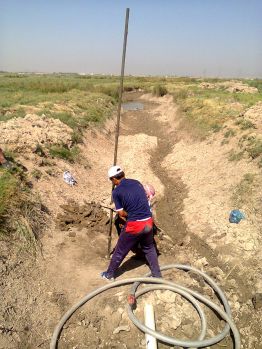Hand-Auger Borings: Difference between revisions
Rmanwaring (talk | contribs) No edit summary |
Rmanwaring (talk | contribs) No edit summary |
||
| Line 13: | Line 13: | ||
<!-- Introductory paragraph or topic page summary --> | <!-- Introductory paragraph or topic page summary --> | ||
"Hand augers are useful for advancing holes to shallow depths, but normally limited to less than 20 feet. A bucket-type hand auger provides samples useful for logging and interpretation. Motorized hand augers (post-hole augers) are available but are also depth-limited."<ref name="NEH_CH5">[[National Engineering Handbook: Chapter 5 - Engineering Geology Logging, Sampling, and Testing | National Engineering Handbook: Chapter 5 - Engineering Geology Logging, Sampling, and Testing, NRCS, 2012]]</ref> | "Hand augers are useful for advancing holes to shallow depths, but normally limited to less than 20 feet. A bucket-type hand auger provides samples useful for logging and interpretation. Motorized hand augers (post-hole augers) are available but are also depth-limited."<ref name="NEH_CH5">[[National Engineering Handbook: Chapter 5 - Engineering Geology Logging, Sampling, and Testing | National Engineering Handbook: Chapter 5 - Engineering Geology Logging, Sampling, and Testing, NRCS, 2012]]</ref> | ||
"Auger borings often provide the simplest method of soil investigation and sampling. They may be used for any purpose where disturbed samples are satisfactory and are valuable in advancing holes to depths at which undisturbed or in-place testing is required. Mechanical hollow-stem auger [[drilling]] and sampling are the most preferred methods for drilling in existing dam embankments to avoid hydraulic fracturing. Hollow-stem augers are frequently used for drilling potentially contaminated ground because fluids are not used. Sometimes, depths of auger investigations are limited by the ground-water table, by rock, and by the amount and maximum size of gravel, cobbles, and boulders as compared with the size of equipment being used."<ref name="EarthManualP1">[[Earth Manual Part 1 | Earth Manual Part 1, USBR 1998]]</ref> | |||
"A soil auger can be used both for boring the hole and for bringing up disturbed samples of soil. It operates best in somewhat loose, moderately cohesive, moist [[soils]]. Usually, holes are bored without addition of water; but in hard, dry soils or in cohesionless sands, introduction of a small amount of water into the hole will aid with drilling and sample extraction. It is difficult to avoid some contamination or mixing of soil samples obtained by small augers. Rock fragments larger than [[about]] one-tenth the diameter of the hole cannot be successfully removed by normal augering methods. Large-size holes permit examination of soils in place; therefore, they are preferred for foundation investigation."<ref name="EarthManualP1" /> | |||
==Best Practices Resources== | ==Best Practices Resources== | ||
{{Document Icon}} [[National Engineering Handbook: Chapter 5 - Engineering Geology Logging, Sampling, and Testing | National Engineering Handbook: Chapter 5 - Engineering Geology Logging, Sampling, and Testing (NRCS, 2012)]] | {{Document Icon}} [[National Engineering Handbook: Chapter 5 - Engineering Geology Logging, Sampling, and Testing | National Engineering Handbook: Chapter 5 - Engineering Geology Logging, Sampling, and Testing (NRCS, 2012)]] | ||
{{Document Icon}}[[Earth Manual Part 1 | Earth Manual Part 1 (USBR, 1998)]] | |||
<!-- In the location of an in text citation, simply enclose the citation as follows: <ref> citation </ref>. Citations will automatically populate. Learn more at https://www.mediawiki.org/wiki/Help:Cite. --> | <!-- In the location of an in text citation, simply enclose the citation as follows: <ref> citation </ref>. Citations will automatically populate. Learn more at https://www.mediawiki.org/wiki/Help:Cite. --> | ||
Revision as of 21:11, 1 November 2022

|
| Drilling a Well with an Hand Auger |
"Hand augers are useful for advancing holes to shallow depths, but normally limited to less than 20 feet. A bucket-type hand auger provides samples useful for logging and interpretation. Motorized hand augers (post-hole augers) are available but are also depth-limited."[1]
"Auger borings often provide the simplest method of soil investigation and sampling. They may be used for any purpose where disturbed samples are satisfactory and are valuable in advancing holes to depths at which undisturbed or in-place testing is required. Mechanical hollow-stem auger drilling and sampling are the most preferred methods for drilling in existing dam embankments to avoid hydraulic fracturing. Hollow-stem augers are frequently used for drilling potentially contaminated ground because fluids are not used. Sometimes, depths of auger investigations are limited by the ground-water table, by rock, and by the amount and maximum size of gravel, cobbles, and boulders as compared with the size of equipment being used."[2]
"A soil auger can be used both for boring the hole and for bringing up disturbed samples of soil. It operates best in somewhat loose, moderately cohesive, moist soils. Usually, holes are bored without addition of water; but in hard, dry soils or in cohesionless sands, introduction of a small amount of water into the hole will aid with drilling and sample extraction. It is difficult to avoid some contamination or mixing of soil samples obtained by small augers. Rock fragments larger than about one-tenth the diameter of the hole cannot be successfully removed by normal augering methods. Large-size holes permit examination of soils in place; therefore, they are preferred for foundation investigation."[2]
Best Practices Resources
![]() Earth Manual Part 1 (USBR, 1998)
Earth Manual Part 1 (USBR, 1998)
Citations:
Revision ID: 4070
Revision Date: 11/01/2022
